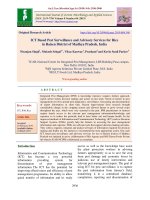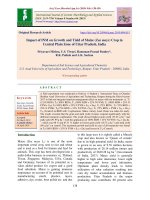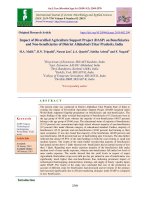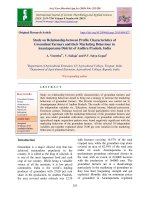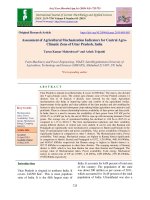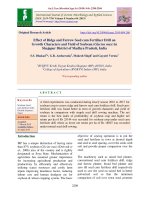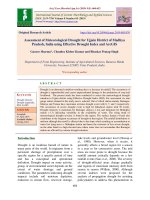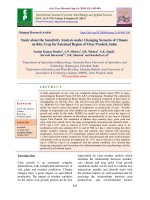Assessment of agricultural mechanization indicators for central AgroClimatic Zone of Uttar Pradesh, India
Bạn đang xem bản rút gọn của tài liệu. Xem và tải ngay bản đầy đủ của tài liệu tại đây (373.14 KB, 9 trang )
Int.J.Curr.Microbiol.App.Sci (2019) 8(5): 725-733
International Journal of Current Microbiology and Applied Sciences
ISSN: 2319-7706 Volume 8 Number 05 (2019)
Journal homepage:
Original Research Article
/>
Assessment of Agricultural Mechanization Indicators for Central AgroClimatic Zone of Uttar Pradesh, India
Tarun Kumar Maheshwari* and Ashok Tripathi
Farm Machinery and Power Engineering, VSAET, Sam Higginbottom University of
Agriculture, Technology and Sciences (SHUATS), Allahabad-211 007, UP, India
*Corresponding author
ABSTRACT
Keywords
Mechanization
index, Power
Availability, Total
energy, Mechanical
Energy, Cropping
Intensity
Article Info
Accepted:
10 April 2019
Available Online:
10 May 2019
Uttar Pradesh is situated in northern India. It covers 243290 Km2. The state is also divided
into 9 agro-climatic zones. The central agro-climatic zone of Uttar Pradesh contains 14
districts. Out of 14 districts 4 districts were selected for the study Agriculture
mechanization also helps in improving safety and comfort of the agricultural worker,
improvements in the quality and value addition of the farm produce and also enabling the
farmers to take second and subsequent crops making Indian agriculture more attractive and
profitable. There is a linear relationship between availability of farm power and farm yield.
In India, there is a need to increase the availability of farm power from 2.02 kW per ha
(2016-17) to 4.0 kW per ha by the end of 2030 to cope up with increasing demand of food
grains. The average size of operational holding has declined to 1.08 ha in 2015-16 as
compared to 1.15 in 2010-11. The farm mechanization indicators and their variability
among different districts of central zone were studied. It can be seen that Kannauj and
Pratapgarh are significantly more mechanized in comparison to Hardoi and Etawah on the
basis of mechanization index and power availability. Also, power availability of Kannuj is
significantly highest in comparison to other 3 districts. The Mechanization index, Power
availability, Total energy, Mechanical energy, are highest in Kanuuj district significantly
in comparison to Hardoi, Etawah and Pratapgarh ie 0.972, 3.29 kW/ha, 4901.40 kWh/ha,
and 4810.67 kWh/ha respectively but Human energy is highest in Hardoi district i.e.
897.75 kWh/ha in comparison to other three districts. The cropping intensity of Kannuj
district is 260% which is less than Hardoi but more than Etawah and Pratapgarh. The
average value of Mechanization index, Power availability, Total energy, Mechanical
energy in central zone of UP are 0.9497, 2.18 kW/ha, 2450 kWh/ha, 2351.86 kWh/ha,
97.89 kWh/ha respectively
India. It accounts for 6.88 percent of total area
of the country. The population of the state
was about 200 million as per census of 2011,
which accounted for 16.49 percent of the total
population of India. Uttarakhand was also a
Introduction
Uttar Pradesh is situated in northern India. It
covers 243290 Km2. This is most populous
state of India. It is the fifth largest state of
725
Int.J.Curr.Microbiol.App.Sci (2019) 8(5): 725-733
part of Uttar Pradesh till November, 2000.
The state is divided into 4 divisions, namely.
Western (28 districts), Eastern (28 districts),
Central (14 districts) and Bumdelkhand (7
districts). At present state have 75 districts,
327 tehsils, 822 blocks and 107452 revenue
villages. The state is also divided into 9 agro
climatic zones, 1. Tarai Region 2. Western
Plain Region) 3. Central Western Region 4.
South Western Region 5. Central Plain
Region 6. Bundelkhand Region 7. North
Eastern Plain Region 8. Eastern Plain Region
9. Vindhyachal Region.
food grains. The average size of operational
holding has declined to 1.08 ha in 2015-16 as
compared to 1.15 in 2010-11.
Zangeneh
et
al.,
(2010)
defined
Mechanization Index (MI) and Level of
Mechanization (LOM), to characterize
farming system of potato in the Hamadan
province of Iran. These indicators are defined
mathematically as equations (1) and (2)
respectively. The MI elaborated here is an
expression of the deviation of the actual
amount of motorized farm work from the
normal values at the regional level.
Agriculture Mechanization is an essential
input to modern agriculture to increase the
productivity and for making judicious use of
other inputs like seeds, fertilizers, chemicals
& pesticides and natural resources like water,
soil nutrients etc. besides reducing the human
drudgery and cost of cultivation. Agriculture
Mechanization also helps in improving safety
and comfort of the agricultural worker,
improvements in the quality and value
addition of the farm produce and also
enabling the farmers to take second and
subsequent crops making Indian agriculture
more attractive and profitable. It also helps
the Indian farming to become commercial
instead of subsistence. The small and
marginal holdings taken together (0.00-2.00
ha) constituted 86.21% in 2015-16 against
84.97% in 2010-11. Semi-medium and
Medium operational holdings (2.00-10.00 ha)
in 2015-16 were only 13.22% with 43.61%
operated area. The large holdings (10.00 ha &
above) were merely 0.57% of total number of
holdings in 2015-16 and had a share of 9.04%
in the operated area as against 0.71% and
10.59% respectively for 2010-11 census.
There is a linear relationship between
availability of farm power and farm yield.
Therefore, there is a need to increase the
availability of farm power from 2.02 kW per
ha (2016-17) to 4.0 kW per ha by the end of
2030 to cope up with increasing demand of
Where, MI = Mechanization Index for the
production unit `a`,
Me (i) = Overall input energy due to
machinery in the production unit `a`,
Mav = Regional-average energy due to
machinery,
Li =Land area cultivated in the production
unit `a`,
Tli = Total farm land ownership of production
unit `a`,
n = Number of farms.
The MI index, proposed by Andrade and
Jenkins, 2003 is an indication of the amount
of machinery a given farmer uses for farm
work compared with the average in the
region. The second term in Equation (1)
includes a ratio between the land area
cultivated with soybean crop and the total
land ownership. This term was introduced
because it reflects the importance of land
demand for cultivation. The LOM index is
based on the premise that a mechanized
farmer is the one that finds a way to utilize
amounts of mechanical energy that are higher
than the typical values using locally available
technology.
726
Int.J.Curr.Microbiol.App.Sci (2019) 8(5): 725-733
considering district and village as strata. The
villages were selected from four mentioned
districts of central zone of Uttar Pradesh using
random sampling and 4 districts out of 14
district of central zone were taken for the
study. Then from each district, 5 villages and
then from each villages, 10 farmers were
selected using random sampling. Primary data
were collected from 200 farmers from 20
villages of 4 districts i.e. 50 farmers from
each district. As mechanization is a multidimensional concept, thus the following
indices were evaluated to study the
mechanization status in target region. To
study the mechanization status of four
districts of Central zone of Uttar Pradesh The
many variables were selected based on
requirements to estimate degree of
mechanization, level of mechanization (Power
availability), mechanization index, cropping
intensity, irrigation intensity, input cost and
farmers Income. The following variables were
selected:
Where, LOM = level of mechanization,
Pi= power of tractors,
η = correction factor for utilized power (0.75).
Field capacity was multiplied by rated power
so the quantification of energy expenditure
was made in work units (kWh). The regional
normal will be obtained after compiling a full
dataset of all respondents and then it would be
defined the mode for the number of passes for
each operation as well as the mode in tractor
size and field capacity.
The level of mechanization is calculated by
the following formula (Almasi et al., 2000).
Mechanization
level
The Total power of existing tractors (hp) =
Average nominal power of one tractor x
Number of working tractors.
Total real power of tractors= Total power of
existing tractors x Conversion coefficient
(0.75).
Animal energy (hp-h) = Total existing animal
power x Annual functional hours.
Annual functional hours = Number of
functional days x Mean functional hours
during a day.
Total existing animal power (hp) = Produced
power of animal x Number of animals.
Human energy (hp-h) can also be calculated
in the same manner.
Degree of mechanization (MD)
It is one of the quantitative measure of
mechanization, by which the degree of
mechanization of different operations in a
cropping system like land preparation,
sowing, weeding, irrigation, spraying,
harvesting, threshing, transportation of agricultural produce and etc. can be assessed. It is
the ratio of mechanization area accomplished
to the area to be mechanized (Almasi et al.,
2000). The degree of mechanization of
particular implements used in a particular
agricultural operation can be given as:
Materials and Methods
Degree of Mechanization = Mechanized
area/Area to be Mechanized...,(4)
After selection of variables, a questionnaire
was prepared to collect primary data from
Etawah, Kannuj, Hardoi and Pratapgarh
districts of central Uttar Pradesh. A Stratified
Multistage Sampling Design was applied
In other words, the degree of mechanization
can be used to evaluate the extent of different
agricultural operations performed using
machinery or improved implements to the
727
Int.J.Curr.Microbiol.App.Sci (2019) 8(5): 725-733
operations performed by humans, animals or
traditional implement i.e. Area under
bullocks, cultivator, power tiller, disc plough,
M B plough, deshi hal (local plough), seed
cum fertilizer drill, diesel engine, electric
pump, sprinkler, dripper, sprayer (manually
operated), sprayer (tractor operated), manual
harvesting, thresher and combine harvester.
engines and electric pump power are human,
draught animal, tractors, power tiller and selfpropelled machines (combines, dozers,
reapers, sprayers and etc.) where as the source
of stationary power is oil engines and electric
motors. In this study, power availability was
also evaluated for Etawah district of Uttar
Pradesh. The main sources of mobile power
were human, draught animal, tractors and
combines whereas the sources of stationary
power were oil engines, electric motors and
threshers in the Etawah District. The power
availability was evaluated using formula
given by Eq. 6.
Level of mechanization (power availability
or farm power)
Farm power is an essential input in
agricultural production system to operate
different types of equipment for timely field
completion of agricultural works to increase
productivity and maintain sustainability of
farm. The mobile power is used for different
field jobs like land preparation, sowing,
weeding, spraying, and harvesting etc.,
whereas stationary power is used for lifting
water, operating irrigation equipment,
threshing, cleaning and grading of agricultural
produce. The main sources of mobile power
are human, draught animal, tractors, power
tiller and self-propelled machines (combines,
dozers, reapers, sprayers and etc.) where as
the source of stationary power is oil engines
and electric motors. In this study, power
availability was also evaluated for 4 districts
of Uttar Pradesh. The main sources of mobile
power were human, draught animal, tractors
and combines whereas the sources of
stationary power were oil engines, electric
motors and threshers in the 4 districts. The
power availability was evaluated using
formula given by Eq. 5.
Power availability (hp/ha) = Total Power/ Net
Cultivated Area...(6)
Where, Total power = Total mobile power +
Total stationary powerNet Cultivated Area =
Net Cultivated Area of Target Region
Villages wise number of tractor, combine
harvester, bullocks, agricultural workers,
power tiller, diesel engines and electric pump
Mechanization index (MI)
Farm operation wise mechanization index is
one of the quantitative measures of
mechanization and it can be defined as per
capita power in terms of hp per hectare for a
particular region. Evaluation of operation
wise mechanization index first then Farmers
wise human power, animal power and
machinery power availability like tractor,
thresher, combine. In this study, a new
approach to evaluate Mechanization Index
was used to overcome the demerits in the
previous
methodology
to
evaluate
Mechanization Index and is given below:
Power availability (hp/ha) = Total Power/Net
Cultivated Area...(5)
Where, Total power = Total mobile power +
Total stationary power
Net Cultivated Area = Net Cultivated Area of
Target Region Villages wise number of
tractor,
combine
harvester,
bullocks,
agricultural workers, power tiller, diesel
r s
MIi
= ( ∑ ∑ M pjk × M tjk) /
j=1k
=1
728
Int.J.Curr.Microbiol.App.Sci (2019) 8(5): 725-733
s
r
s (M × M
[∑ ∑ pjk tjk +
j=1k=
1
t
jk
+H
p
jk
k = 1 to s, where s is no of farm practices in
jth crop
×M
Results and Discussion
The graphical representation of variation of
Mechanization index, Power availability,
Total energy, Human energy, Mechanical
energy, Degree of mechanization, Cropping
intensity, Irrigation intensity, Farmers income
and Input cost in four districts i.e. Kannuj,
Hardoi, Etawah, Pratapgarh are shown in
figure from 1 to 12. The farm mechanization
indicators and their variability among
different districts of central agro climatic zone
were studied. It was observed that all the
mechanization indicators varied significantly
among districts as p < 0.05 (Table 1). The
comparisons of indicators for different
districts have been performed using LSD
values and presented in (Table 2). It can be
seen that Kannauj and Pratapgarh are
significantly more mechanized in comparison
to Hardoi and Etawah on the basis of
mechanization index and power availability.
Where,
MIi = Mechanization Index of ith farm
Mpjk = Power of machine used in kth
operation in j th crop (including stationary
and movable)
Mtjk = Time taken by machine to perform kth
operation in jth crop Hpjk = Power of human
used
in kth operation in jth crop (including
stationary and movable)
Htjk = Time taken by human to perform kth
operation in jth crop
Apjk = Power of animal used in kth operation
in jth crop (including stationary and movable)
Atjk = Time taken by animal to perform kth
operation in jth crop
i = 1 to n, where n is number of farm j = 1 to
r, where r is number of crop cultivated in a
calendar year
Table.1 ANOVA for mechanization indicators
Source
Model
DF
3
Error
Total
R2
CV
8
11
-
p-values
Mechanization
Index
<.0001
0.930625
0.998967
Total
Energy
0.0090
0.747170
54.06511
Human
Energy
<.0001
0.964072
19.38278
Mechanical
Energy
0.0089
0.747449
55.49522
Power
availability
0.0154
0.709103
22.37329
Table.2 Comparison of mechanization indicators
Indicators
Mechanization Index
Total Energy (kWh/ha)
Human Energy(kWh/ha)
Mechanical Energy(kWh/ha)
Power Availability (kW/ha)
District
Kannuj
0.972a
4901.40a
90.73bc
Hardoi
0.968b
897.75d
897.75b
Etawah
0.942c
1250.69c
50.95d
Pratapgarh
0.97a
2749.20 b
226.32a
LSD
0.0179
2882.7
33.876
4810.67a
3.29a
874.17d
1.72c
1199.74c
1.53d
2522.88b
2.21b
2861.9
1.0167
729
Int.J.Curr.Microbiol.App.Sci (2019) 8(5): 725-733
730
Int.J.Curr.Microbiol.App.Sci (2019) 8(5): 725-733
731
Int.J.Curr.Microbiol.App.Sci (2019) 8(5): 725-733
Also, power availability of Kannuj is
significantly more in comparison to other 3
districts.
The
comparison
of
other
mechanization indicators can be observed in
Table 2.
Guidelines
for
Agricultural
mechanization strategy in development.
Economic and Social Commission for
Asia and the Pacific (ESCAP), Regional
Network for Agricultural machinery.
6. Morris, J. 1985. The economics of small
farm mechanization. In „Small Farm
Mechanization
for
Developing
Countries‟ (eds P. Crossley and
Kilgour), pp. 171-184, John Wiley and
Sons: New York.
7. Nowacki, T. 1978. Methodology used by
ECE
Countries
in
fore-casting
mechanization developments. United
Nations Economic Commission for
Europe, AGRI/ MECH Report No. 74.
8. Nowacki, T. 1984. Changes and trends in
the quantity and balance of energy
consumption in agriculture (general
methodology).
FAO/ECE/AGRI/
MECH Report, No. 105, Geneva p. 36.
9. Andrade, P. and B. Jenkins, 2003.
“Identification of Patterns of Farm
Equipment
Utilization
in
Two
Agricultural Regions of Central and
Northern
Mexico”.
Agricultural
Engineering International: the CIGR
Journal of Scientific Re-search and
Development. Invited Overview Paper.
Vol. V. June 2003.
10. Ramirez, A. A., A. Oida, H. Nakashi-ma,
J. Miyasaka, and K. Ohdoi. 2007.
Mechanization index and machinery
energy ratio assessment by means of an
Artificial Neural Network: A Mexican
case study. Agricultural Engineering
International. Manuscript PM 07002, 2.
11. Rijk, A. G. 1989. Agricultural
mechanization policy and strategy- the
case of Thailand. Asian Productivity
Organization, Tokyo, Japan.
12. Singh, G. and D. De. 1999. Quantification
of a mechanization indicator for Indian
agriculture. Applied Engineering in
Agriculture, 15(3): 197-204.
13. Singh, G. 2006. Estimation of a
In conclusion, the Mechanization index,
Power availability, Total energy, Mechanical
energy, are highest in Kanuuj district
significantly in comparison to Hardoi, Etawah
and Pratapgarh i.e. 0.972, 3.29 kW/ha,
4901.40 kWh/ha, and 4810.67 kWh/ha
respectively but Human energy is highest in
Hardoi district in comparison to other three
districts. The average value of Mechanization
index, Power availability, Total energy,
Mechanical energy in central zone of UP are
0.9497, 2.18 kW/ha, 2450 kWh/ha, 2351.86
kWh/ha, 97.89 kWh/ha respectively. The
cropping intensity of Kannuj district is 260%
which is less than Hardoi but more than
Etawah and Pratapgarh.
References
1. Anonymous. 2018. Agriculture Census
2015-16 (Phase I) Provisional Results,
Department of Agriculture, Cooperation
& Farmers Welfare, Government of
India (GOI). Report of Agriculture
census 2015-16
2. Anonymous. 2018. Annual Report 201718,
Department
of
Agriculture,
Cooperation & Farmers Welfare,
Ministry of Agriculture and Farmers
Welfare, Government of India, New
Delhi, 93 p.
3. Roy Ramendu and Hasib Ahmad, 2015:
State Agricultural Profile of Uttar
Pradesh. Report of Agriculture profile
2014-15.
4. Almasi, M., S. Kiani, and N. Loui-mi.
2000. Principles of Agricultural
Mechanization. Ma soumeh (PBUH)
Publication. Ghom, Iran. PP. 19-40.
5. Gifford, R. C., and A. G. Rijik. 1980.
732
Int.J.Curr.Microbiol.App.Sci (2019) 8(5): 725-733
mechanization index and its impact on
production and economic factors- A
case study in India. Bio-systems
Engineering, 93(1): 99-106.
14. Zangeneh, M., M. Omid, and A. Akram.
2010. Assessment of agricultural
mechanization
status
of
potato
production by means of Artificial
Neural Network model. Australian
Journal of Crop Science, 4(5): 372-377.
How to cite this article:
Tarun Kumar Maheshwari and Ashok Tripathi. 2019. Assessment of Agricultural
Mechanization Indicators for Central Agro-Climatic Zone of Uttar Pradesh, India.
Int.J.Curr.Microbiol.App.Sci. 8(05): 725-733. doi: />
733

